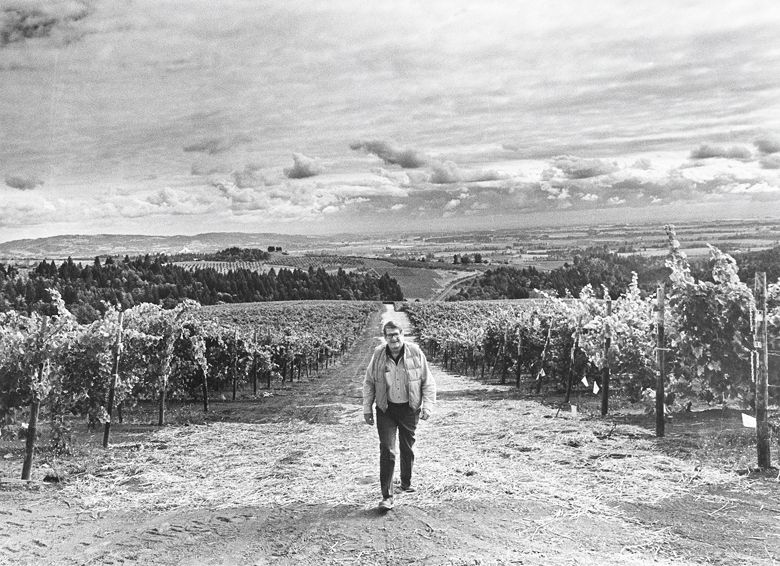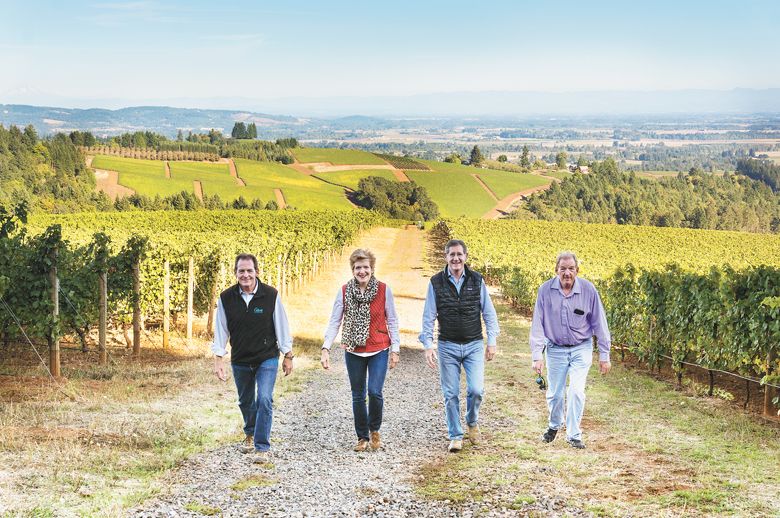From Inconspicuous to Illustrious
Pioneer grows the industry


Compared to other pioneering Oregon wineries— Hillcrest Vineyard (Richard Sommer), Charles Coury Winery, The Eyrie Vineyards (David Lett), Ponzi Vineyards, Erath Winery, and Adelsheim Vineyard— Knudsen Vineyards has flown under the radar. Yet, by 1972, Cal and Julia Lee Knudsen (with help from Dick Erath) had established the largest planting of Pinot Noir and Chardonnay in the state (and quite possibly the country).
After living in Portland, but before pursuing grape growing and winemaking in the Willamette Valley, the family moved to Seattle in 1969 for Cal’s corporate job in the forest products industry. Knudsen’s model, however, was quite different from many of those original pioneers, the resourceful entrepreneurs living on their land and developing their vineyards with sweat equity.
“Because of our father’s career as a corporate acquisition specialist at Weyerhaeuser, we lived in the Seattle area; thus our family was not as present in the Valley as the other wine pioneers,” explains Page Knudsen Cowles, Knudsen Vineyards’ second-generation owner and managing partner. Back in 1971, Knudsen’s 200-acre property consisted of dirt, wild blackberries and trees that needed taming to make way for grapevines.
She remembers those days, “Our family was pressed into service to plant the original vineyard. We were living in Seattle, and the whole family— my three brothers, my mother and my father— drove to Dundee to plant the first rows of vines in the red Jory soil of the Dundee Hills.”
Knudsen Cowles recalls how she and her older brothers worked summers at the vineyard. “I learned alongside local women working while their kids were in school. As we walked down the rows, I would hear them talking to each vine, greeting every plant like a valued friend. I had never seen anyone treat a plant like that, and it stuck with me.”
With Dick Erath managing the ground effort, Knudsen increased plantings to 55 acres to create the largest vineyard in the state. In 1975, with the first commercial crop, the two men formed the initial commercial scale bonded winery in the Dundee Hills, Knudsen Erath Winery. A year later, they opened a tasting room and sold wine to curious visitors.
Unsurprisingly, Oregon Pinot Noir began gaining worldwide recognition for its elegance, individuality, and quality. The international wine world took notice in 1985 when three Willamette Valley Pinot noirs earned coveted top spots in a comparative tasting against wines from Burgundy, France. The French protested that their wines needed more time in bottle so a re-match was scheduled. Once again, much to the chagrin of the French, Willamette Valley Pinots dominated. Tied for first place in the second comparative tasting were the 1983 vintage of Knudsen Erath Pinot Noir and The Eyrie Vineyards.
From the start, the Knudsens hoped to produce sparkling wine. However, cost constraints and risk assessment led them to focus exclusively on still wines. At the time, with plantings from 500-1000 feet, Knudsen Vineyard was the highest elevation vineyard in the area, perfectly suited for a sparkling wine program. In 1987, after establishing a relationship with Rollin Soles and Brian Croser, owners of the newly established Dundee Wine Company, now named Argyle Winery, Knudsen began supplying the winery with fruit from his vineyard. This relationship accomplished the couple’s dream of producing sparkling wine from their grapes.
“Eventually, we resurrected the Knudsen Vineyards label and began producing wine under the brand in 2012. More recently, mere months after the pandemic hit, we opened The Outlook at Knudsen Vineyards, our estate tasting room, once again allowing visitors direct access to our half century-old family enterprise,” says Knudsen Cowles.
“Wine serves as connective tissue for friendship and community,” explains Knudsen Cowles. We believe and hope that the legacy of Knudsen Vineyards is two-fold: continuing to lead the Oregon wine industry in sustainable viticulture practices and offering our guests an elevated experience, authentic to our heritage, the beauty of our site, and the exceptional and unique quality of our wines.”
Today, visitors can schedule a vineyard hike with Knudsen Cowles and learn her memorable stories recounting the vineyard’s history over the decades. It affords the opportunity to walk through the original plantings— rootstalks fat and plump with a half-century of vintages at their core— and gaze at the valley below, experiencing firsthand the promise Knudsen envisioned there so many years ago.
The future already contains some exciting developments. The family is midway into a sparkling wine production program that will see the release of their first, estate-grown, Blanc de Blancs in 2024. Knudsen Cowles concludes, “My brothers and I feel that our parents would be pleased and proud of how we continue to develop their original vision for the property. We feel tremendous satisfaction sharing its beauty and bounty with people near and far.”









